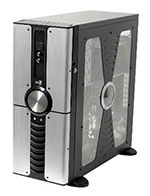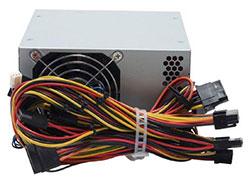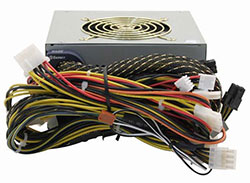Buyer's Guide: Mid-Range to High-End, May 2005
by Jarred Walton on May 23, 2005 5:30 PM EST- Posted in
- Guides
Case and Power Recommendations
Once you have all the internal parts picked out, it's time to find a home for your computer. This is often one of the most difficult decisions to make, as the case is what you'll actually see on a regular basis. If you're not worried about what the case looks like, you can probably get just about any cheap case at your local store. If you want something larger, smaller, flashier, quieter, etc., there is a case to fit your needs. Prices start at about $30 for the cheapest models (forget about the included power supplies!) and go all the way up to hundreds of dollars. We'll give a basic recommendation and a flashier alternative, but if you're looking for a truly exotic case, you're on your own. Well, maybe not quite on your own, but you get the idea.The power supply is a component that often gets overlooked, and for a modern system, we recommend spending a decent amount of money on a high quality power supply. The days of using the included "free" PSU are over for all but the lowest end computers. Sure, that 500W PSU might work well for a few weeks or months, but if you start experiencing system crashes and random instability, a low grade PSU - often with exaggerated performance characteristics - is a prime culprit. Generally speaking, you get what you pay for, so if a recognized name like Antec or Enermax is selling a 375W PSU for $40 and another manufacturer is claiming 500+ Watts for the same price, you should probably be suspicious at best.
Mid-Range Case Recommendation
Case: Antec SLK3000-B
Price: $56 Shipped
For good build quality at a relatively low price, Antec is always a safe bet. We're actually going to pull something of a cop-out and stick with an Antec SLK3000-B as our recommendation. It's nothing special in terms of looks, but it's reasonably quiet, affordable, and well designed. One 120mm fan is provided at the rear of the case with room for a second up front, and rails aid in the installation of hard drives and optical drives. About the only thing that you might find missing is front Firewire and audio ports, but that's not a major concern for most people. The SLK3700-BQE is a slightly more expensive model that does away with the CPU duct and the ventilation holes on the side panel while adding a 350W PSU. While we feel that most Mid-Range and higher PCs should have a better PSU, 350W ought to suffice for many people.
High-End Case Alternative
Case: AeroCool Spiral Galaxies
Price: $108 Shipped
This is definitely not a case for everyone, but we think that some people will really like it, so we're listing it as an option. It's a very large (full tower) case, so if that's not your style, look elsewhere. It does have some innovative features, like a wind tunnel to help keep the CPU cool. The wind tunnel has 120mm fans at the front and rear of the case, ensuring plenty of airflow; it's unfortunate that it doesn't provide air circulation for the GPU area as well, as SLI setups in particular could use some additional ventilation. The motherboard tray is reversed from the standard ATX design - it's on the left panel of the case - but while that's sort of like BTX, the design is still fully ATX compatible. The right panel has a case window with a honeycomb pattern on it (supposedly to reduce EMI), and the case has a door hiding the drive bays that can be locked if necessary. Another plus is the tool-less features for the fans and the expansion slots, and there are even rubber shock absorbers to help reduce noise from vibrations. Besides difference of opinion as to what looks cool, the only real problem is that getting the power cables from your PSU to reach all of the necessary areas can be difficult. If you go with a higher-end PSU, that usually isn't a problem, but you may not be able to determine whether or not a PSU will work until after you've purchased the parts. Overall, it's an interesting and innovative case design at a good price.
Mid-Range Power Supply
PSU: Antec SmartPower 2.0 400W
Price: $66 Shipped
While it is by no means the best power supply that you can find, Antec makes good quality units and provides a standard 3-year warranty for all their products. There are a few cheaper no-name brands that meet the new ATX 2.0 specification, but going with our above statement of prices being a decent indication of quality, we won't recommend a $45 500W ATX 2.0 PSU, as it simply sounds too good to be true. The 400W Antec model meets all the requirements of ATX 2.0, and the price matches up with the features. It has a 24-pin power connection for the motherboard as well as a 4-pin ATX12V adapter, one 6-pin PCIe power connection, two SATA power connections, four 4-pin molex adapters and a 4-pin floppy adapter. It also has dual 80mm fans to keep the internals cool, although that does cause it to create more noise than some other models.
The biggest complaint we have is that all of the cables are bare, meaning that there is no sheathing to make things look tidier. It doesn't really affect performance in any way, but if you have a case window, you might want something more attractive like an OCZ ModStream 450W. That runs about $25 more than the Antec and doesn't include dual 12V rails, but it does have a 24-pin power connector and you only need to plug in the cables that you're using. (The X-Connect Ultra, Antec NeoPower, AeroCool Turbine Power and probably several other PSUs have a similar design.) Fotron Source also makes a 500W PSU with sheathed cables that meets the ATX 2.0 spec, but it doesn't feature detachable cables. It might be a bit cheaper for comparable performance, but it still costs $90.
High-End Power Supply
PSU: Enermax EG565P-VE FMA2.0 SLI 535W
Price: $97 Shipped
For a high-end SLI system, you'll want to make sure that you have a very high quality power supply. The SmartPower 2.0 that we recommended above might be able to run such a setup as long as you didn't want more than one or two hard drives, but you're certainly pushing the limits of the PSU. A high powered graphics card like the 6800GT can easily draw 75W, so two of them running in SLI could use over 150W when gaming. Throw another 100W to the processor, and you've already used a sizeable chunk of the available power. We may have to look into the reliability of various PSUs in a future article, but for now, we would rather err on the side of caution, so we're going to go with power supplies in the 500W and higher range (or at least close to that). There are plenty of power supplies that still meet that requirement, including the 500W Antec SmartPower. However, since we're planning to use this in an SLI setup, what better way to guarantee proper support than to get an SLI certified PSU?
The Enermax Whisper II 2.0 (do you multiply to get 4.0?) has the relatively unique feature of including two 6-pin PCIe power connections. You also get the 24-pin and 12VATX connections for the motherboard, seven 4-pin molex plugs, two 4-pin floppy connections, and four SATA power adapters. The 535W of total power output should be more than sufficient for all but the most extreme configurations. The only real drawbacks are similar to that of the SmartPower. With the exception of the 24-pin cable, the cables aren't sheathed, so they look rather messy. You could sheath them yourself, but that's rather inconvenient.
If you're looking for other alternatives, there are quite a few PSUs that should work fine even with a high-end SLI configuration. Antec has their TruePower 2.0 units, Fotron Source and Seasonic are usually a good bet, and if you liked the alternative case recommendation, there's even a 550W AeroCool PSU that should work well. OCZ offers their ModStream, PowerWhisper and PowerStream units and they should all suffice, though the 600W PowerStream weighs in at a hefty $200+ price. Finally, Silverstone and CoolerMaster also have ATX 2.0 compliant power supplies that compare in price with the others in this list. You could probably get by with a power supply in the 400 to 450W range if you don't add too much other stuff to your system, but when you're talking about spending $700 or more just on graphics cards, we think that it's rather silly to try to save $10 or $20 on the power supply. It's a mistake that can come back to haunt you. It's better to have 150W more power than you need than to come up 25W short.














60 Comments
View All Comments
Tujan - Tuesday, May 24, 2005 - link
Err a,thanks for reply..Calin.bummer when I do that.
Garyclaus16 - Tuesday, May 24, 2005 - link
All this article tells me is that my once 'bleeding edge' [939 Athlon64 3200+]system is now merely a mid range PC...save for my pqi turbo 2-2-2-5 :PStill...I am sad...I need to save up another 2k now for later this year. > :(
Tujan - Tuesday, May 24, 2005 - link
Thanks for reply Chris..Yeah Ive followed a few stories about the VIA Edens. Just hovering around 1 GHz. With single PCI slot.They too,have onboard graphics. Like pull that off , keep onboard sound maybe,...
Certainly limiting themselves with that kind of choice.Then Im not what that is suppose to reach. Two PCI-e slots at minimum for me.But this sends the engineers back to work.
Most vendors Iv seen include the graphics onto the mini-atx motherboards. MSI has an mini-atx w/o graphics ,..775.But isn't seen at vendors. Situation with the power,could make do with feature set of 915..945,955/Nvidias on mini-atx(s),.Since the lan is onboard.Might consider having maybe single Sata as well.
Not like being able to see clearly now...""I can see clearly now the rain is gone""..:)
Weird how we will see magic in closed black box embedded solution before we have that choice.
ProviaFan - Tuesday, May 24, 2005 - link
I agree with #34 for the most part, but anyone heavily into digital photography (whether with DSLR or scanned film) knows that it is very easy to exceed 1GB with Photoshop and a few images with some adjustment layers and layer masks (not to mention that my PC is general purpose and I usually have other stuff going in the background as well).stickx - Tuesday, May 24, 2005 - link
quoted from the guide: "long-time favorite, the OCZ Rev. 2 Platinum. While the price increase is quite drastic, it's worth mentioning that this same RAM cost as much as $275 just a few months back. It uses Samsung TCCD memory blanks"Unfortunately OCZ is no longer using TCCD memory in this product. This has been verified on several forums in xtremesystems.org and in dfi-street.com where people have removed the heat spreaders to find chips other that TCCD. I think you need to update your guide for this info.
OrSin - Tuesday, May 24, 2005 - link
Damn people get off thier backs. It a damn guide. Make all the choices you. They are giving thier recommondation, they are not give you ever fcking choice under the sun. No guide can have everyones choice.And ars, I don't know what planet your from but if you think epox is even near Asus or MSI in quality then then you full of it. If i saw any sit say Exop is better then ASUS, then I would stop reading them. Better then chaintech ost likely then not the top tier guys.
And for the record I play alot games and have noticed no improvement with 2GB of 1GB or memory.
Don know what you do thet 2GB is needed. Now I'm not saying you can;t find a way to use more then 1GB, but how many people actually do and on a regular bases.
Pythias - Tuesday, May 24, 2005 - link
When you guys refer to response time, is thet grey-to-grey, black-white-black, or total response time?MrOblivious - Tuesday, May 24, 2005 - link
Supposedly the issue with MSI NEO4 boards and 90nm chips has been fixed:http://forum.msi.com.tw/index.php?topic=80384.0
arswihart - Tuesday, May 24, 2005 - link
Kris - so you are now saying all mobo makers are essentially equal in terms of support, upgrades, MTBF (bad caps excuse is dead now since they all use good/great quality caps). So what's left to make me choose Asus/MSI? If you are saying reputation, I can just direct you to the forums, their boards are no better or worse than any of the competition. If you are recommending based on sales, thats just dumb.ceefka - Tuesday, May 24, 2005 - link
#1 I don't know how the onboard will handle sound in games, but I'd count on it to do that on the level it is built, i.e. no better than it will play a CD or DVD. It is however safe to say that onboard will definately not work for (semi)professional audio on a PC.I always thought that any realtime sound effects were handled by the CPU, unless you have a dedicated DSP-card or multiples thereof which gamers seldom do ;-)
Jarred: "anyone who doesn't intend to do any recording of audio" and what about those that do? I do read a lot about DAW's on the net, but have to get back to AT regularly to get a the details straight.
What do you make of this? http://www.rme-audio.com/english/techinfo/nforce4_...
With the Thonex audio stress test file (downloadable from http://www.adkproaudio.com/downloads.cfm), including memory-intensive data communication via samples/VSTis, and used with Cubase SX/Nuendo 2/3, soundcard latency has to be increased to approx. 2048 samples buffer latency setting with the NF4 to receive glitch-free audio recordings whereas with the NF3, and equivalent software/hardware/soundware equipment, the minimum latency can be significantly reduced (some 128-256 samples). Likewise, cpu load values are significantly higher with the NF4 than with the NF3 ditto - based on exactly the same audio stress test files and equivalent hardware peripherals.
The Thonex could be nice for your next high end guide when the dualcores are out.